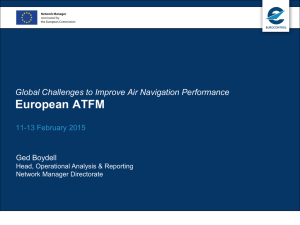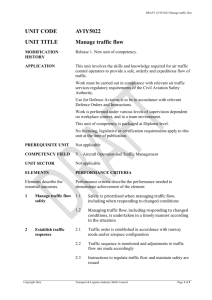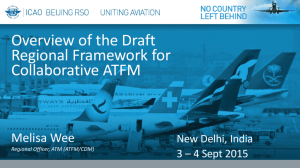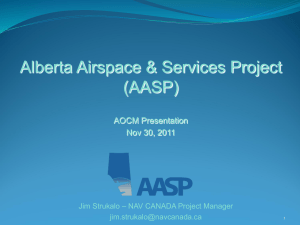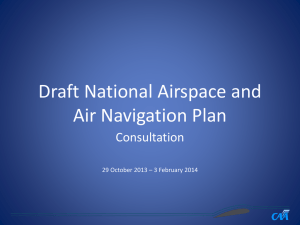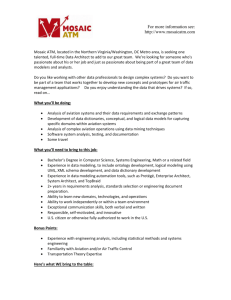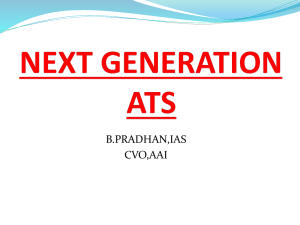First sections v1
advertisement
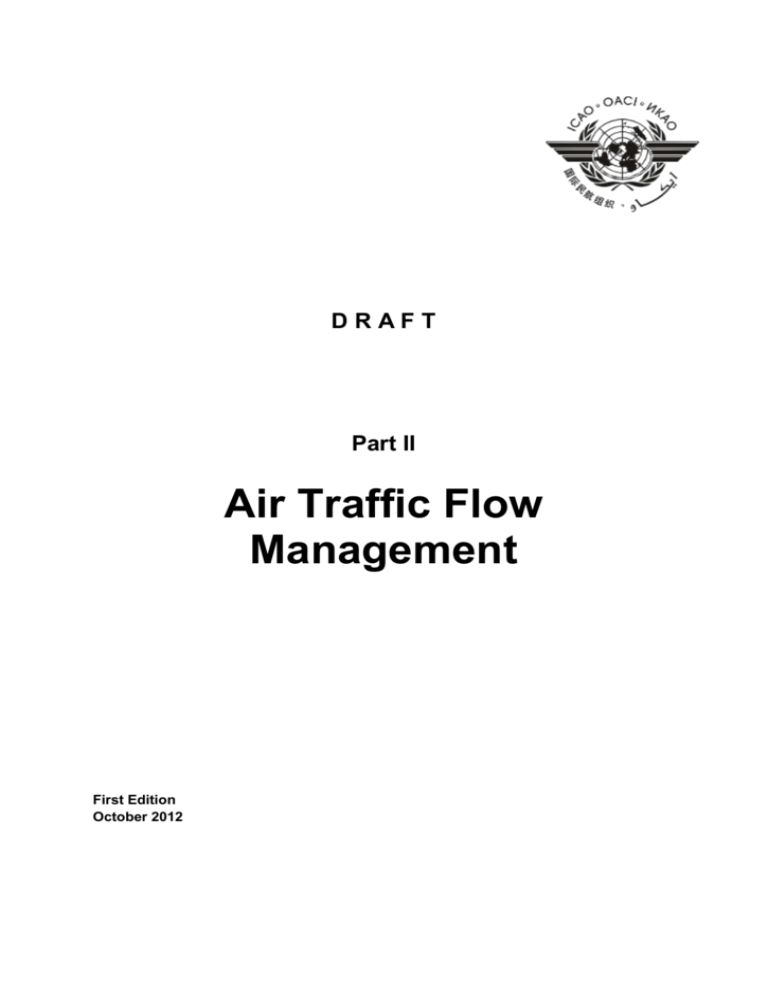
DRAFT Part II Air Traffic Flow Management First Edition October 2012 FOREWORD Because of the continued growth in civil aviation, in many places, demand often exceeds the available capacity of the air navigation system to accommodate air traffic, resulting in significant negative consequences not only to the aviation industry, but also to general economic health. One of the keys to maintaining the vitality of civil aviation is to ensure that a safe, secure, efficient and environmentally sustainable air navigation system is available at the global, regional and national levels. This requires the implementation of an air traffic management system that allows maximum use to be made of enhanced capabilities provided by technical advances. One of the elements of ATM that can be built to attend the expectations of the aviation community is ATFM which is building momentum among Air Navigation Service Providers. While ATFM is proven to enhance safety and provide measurable efficiency gains, it is also viewed as a transformational concept that introduces new levels of collaborative decision making and offer potential for harmonizing seamless airspace operations. It provides a range of benefits to all aviation community improving predictability in the operations from gate-to-gate, improving access and equity in the use of airspace and enabling optimization of curb-to-curb operations. The improvement in efficiency of operations provided by ATFM also contributes to reduce impact of aviation on environment and supports sustainability goals. This guidance material describes the Air Traffic Flow Management processes based on regional and industry experiences. The processes intend to support national ATC capacity planning for enroute, terminal airspace and for airports, and provide guidance for air navigation services providers intending to start an ATFM function using globally recognized procedures. It intends to provide guidance and harmonize the development and the global implementation of Air Traffic Flow Management (ATFM) supporting worldwide collaboration among the different partners involved in ATFM such as: a) Air navigation service providers, including; 1) policy/decision makers; 2) airspace designers; and 3) operational Air Traffic Management (ATM) staff; b) Aircraft operators: 1) policy/decision makers; 2) pilots; and 3) technical staff; c) Airport operators, including: 1) operations department; and 2) environment department; d) Regulatory authorities; and e) Military authorities. TABLE OF CONTENTS Page EXPLANATION OF TERMS ABREVIATION AND ACRONYMS EXECUTIVE SUMMARY CHAPTER 1 1.1 INTRODUCTION 1.1.1 Air traffic flow management philosophy 1.1.2 Air traffic flow management pre-requisites 1.1.3 Air traffic flow management benefits 1.2 AIR TRAFFIC FLOW MANAGEMENT OVERVIEW 1.2.1 Operations performance planning and management 1.2.2 Air Traffic Flow Management characteristics 1.2.3 Air Traffic Flow Management Principles 1.2.4 Collaborative Decision-Making Objectives and Principles 1.2.5 CDM Requirements and Benefits 1.2.6 CDM Organization and Structure 1.2.7 Global CDM Resources CHAPTER 2 2.1 ATFM SYSTEM PLANNING 2.1.1 Determining ATFM Requirements 2.1.2 Traffic Management Initiatives CHAPTER 3 3.1 ATFM DEVELOPMENT STRATEGY 3.1.1 ATFM System Preparation 3.1.2 ATFM System Establishment 3.1.3 ATFM System Operation 3.1.4 Planning for Special or Unforeseen Events CHAPTER 4 4.1 INFORMATION EXCHANGE 4.1.1 General 4.1.2 International Data Exchange Standards 4.1.3 System Eligibility for Data Exchange 4.1.4 Connectivity Specifications 4.1.5 Data Type Description and Harmonization 4.1.6 Data Exchange Limitations and Regulations 4.1.7 Allowed Data Usage 4.1.8 Documentation 4.1.9 Tools 4.2 COMMUNICATION 4.2.1 Background 4.2.2 Stakeholder ATFM Communication Structure 4.2.3 Coordination of ATFM Information and Traffic Management Initiatives 4.2.4 Exchanging ATFM Information 4.2.5 ATFM Message Components 4.2.6 Amendment 4.2.7 Cancellation 4.2.8 Operations Plan 4.2.9 Civil/Military Coordination CHAPTER 5 5.1 POST-TACTICAL ATFM TASKS CHAPTER 6 6.1 REFERENCES APPENDICES APPENDIX A: ATFM Communication Phraseologies APPENDIX B: ATFM Training Information APPENDIX C: ATFM Traffic Management Measures APPENDIX D: ATFM Resources APPENDIX E: Sample Data Exchange Agreement APPENDIX F: Special Event Planning Examples EXPLANATION OF TERMS Air traffic management (ATM). The dynamic, integrated management of air traffic and airspace including air traffic services, airspace management and air traffic flow management — safely, economically and efficiently — through the provision of facilities and seamless services in collaboration with all parties and involving airborne and ground-based functions. Air Traffic Flow Management (ATFM). A service established with the objective of contributing to a safe, efficient and sustainable flow of air traffic by ensuring that ATM capacity is utilized to the maximum extent possible, that fully takes account of the economic and operational priorities of the airspace user, and that the traffic volume is compatible with the capacities declared by the appropriate air traffic service (ATS) authority. Capacity. The maximum number of aircraft that can be accommodated in a given time period by the system or one of its components (throughput). Demand. The number of aircraft requesting to use the ATM system in a given time period. Predictability. Predictability refers to the ability of airspace users and ATM service providers to provide consistent and dependable levels of performance. Predictability is essential to airspace users as they develop and operate their schedules. Traffic synchronization. Traffic synchronization concerns the management of the flow of traffic through merging and crossing points, such as traffic around major aerodromes or airway crossings. It currently includes the management and provision of queues both on the ground and in the air. Traffic synchronization, as a function, is closely related to both demand/capacity balancing and separation provision and may in the future be indistinguishable from them. Traffic synchronization also concerns the aerodrome “service” part of the concept. To be populated during the development. ABREVIATION AND ACRONYMS ATC Air Traffic Control ATS Air Traffic Services ATM Air Traffic Management ATFM Air Traffic Flow management FUA Flexible Use of the Airspace CDM Collaborative Decision-Making SMART Specific, measurable, accurate, reliable and timely To be populated during the development. EXECUTIVE SUMMARY This guidance material contains information on how ATFM is applied by using Collaborative DecisionMaking (CDM) processes in order to balance capacity and demand within Air Traffic Control (ATC) and airport environments. It highlights the need of close cooperation among different partners by providing flexibility in the use of the airspace and airport resources. It provides therefore guidance for: a) Air navigation service providers; b) Aircraft operators; c) Airport operators, including airport slot coordinators as appropriate; d) Regulators; e) Military agencies; and f) Industry related to ATFM. Key objectives of this guidance material are to: Establish globally consistent ATFM planning and operating practices; Encourage a collaborative and harmonized approach to ATFM between States and regions; and Encourage a systemic approach to ATFM, including all ATM community members.
